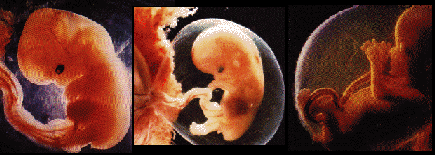The Theory of Evolution is as much as fact as is the Theory of Gravity.
The evidence present in embryology is further solidified by the evidence
found in DNA and in the fossil record. When Charles Darwin first proposed
the Theory of Evolution, most of his evidence came from the fossil record
and the characteristics he saw in birds he collected while exploring the
Galapagos Islands while on his trip on the HMS Beagle. Although the fossil
record is incomplete, the specimens found still provide a reliable source
of evidence for evolution. Of all the fossils that have been found, none
of them have ever been out of place and time in such a way that disproves
evolution; if there ever is found, then the theory of evolution will stand
scientific scrutiny. Darwin also noted early embryology as part of his
evidence. But, the discovery of DNA and DNA sequencing provided the most
supporting evidence of evolution.
Below are listed the same features from the
Human Embryo
section of this webpage; I discuss the fossil and DNA evidence found and
the likely common ancestor that introduced that particular feature into
humans.
| Category | Gill Slits | Ear Bones | Legs and Arms | Tail | Coat of Hair |
|---|---|---|---|---|---|
| Common Ancestor | Fish | Amphipian | Fish | Early Mammal. Ancestor of all living mammals. | |
| Fossil Evidence | Evidence exits, but it is highly unlikely that the common ancestor will found. Few animals become fossilized and of those fewer are discovered by scientists. | ||||
| DNA Evidence | In the past 20 years DNA sequencing has provided overwhelming evidence for evolution. It correlates with the fossil record, the tree of life, and observations in embryology. | ||||
References
- Darwin, Charles. (1869). On the Origin of Species by Means of Natural Selection, or the Preservation of Favoured Races in the Struggle for Life (4th edition). London: John Murray.
